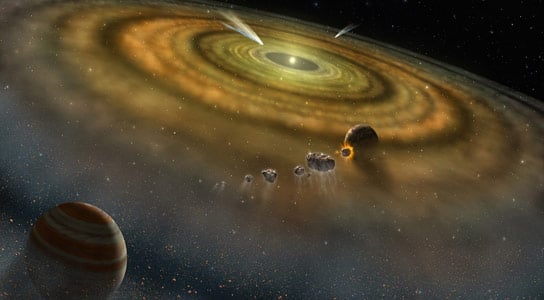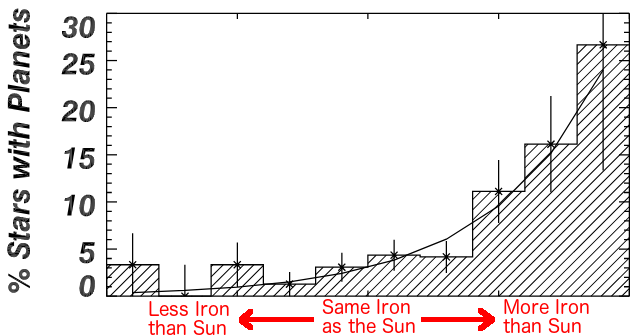
Friday marked the end of the 2021 TESS Science Conference. Hosted virtually by MIT, this workshop marked the second in a series dedicated to exoplanet science related to NASA’s TESS (the Transiting Exoplanets Survey Satellite) mission. From the discovery of a gas giant on the verge of tumbling into its host star to observations of starquakes, the week was crammed too full for a single blog entry to do it justice.
So instead of a full summary, I wanted zero in on one topic that has profound implications for understanding the natures of exoplanets: the planets’ compositions.
You Are What You Accrete

About 400,000 years ago, Neanderthals, our closest cousin hominid, migrated into Europe from the Middle East. Even though much remains mysterious about these early humans’ lifestyles — their mannerisms, their societies, and even whether they could talk — scientists have developed a sophisticated understanding of their diets by looking at their environments and analyzing their remains.
For instance, the remains of a one-year-old Neanderthal baby found in a cave in France exhibit a distinctive isotopic signature. By comparing this signature to the isotopic signatures for surrounding flora and fauna, scientists concluded that this one-year-old was still breastfeeding and his/her mother was probably entirely carnivorous, feeding on local reindeer and horses.
Like these ancient (and even modern) baby humans, infant planets eat what’s around them when they’re growing up. But planets don’t grow up caves — they gravitationally accrete in what are called protoplanetary disks, the gas and dust leftover after their host star forms. As the planets grow, this disk clears out, eventually leaving a mostly empty solar system like our own.
Since the planets in a solar system form from the same materials as the star, looking at the star’s composition tells us the planets’ starting ingredients, like looking at a Neanderthal’s isotopic environment. And by looking a planet’s density, we can estimate how much of which materials made it into the planet, like chemically analyzing the Neanderthal bones. So what have astronomers found out?
Grow Where the Iron’s A Lot

From Fischer & Valenti (2005).
For one, the amount of iron and other heavy elements that were present in a disk essentially determine the number and size of planets in a solar system.
Way back in 2005, Deb Fischer and Jeff Valenti looked at hundreds of planetary systems then known. They estimated the amount of iron in a host star and found that the more iron-rich a star had (and therefore the more iron and other rock-forming elements in the original protoplanetary disk), the more likely the star had gas giant planets in orbit. More than that, they found more iron-rich stars usually had more planets.
In a simple picture of planet formation, this correlation makes sense: the more planet-forming materials available in the protoplanetary disk, the more planets you can make and more larger those planets can be.
Subsequent studies suggest that the presence and number of small, Earth-size planets are less sensitive to the stellar iron content, presumably that’s because you don’t need much material to make small planets. Apparently, a little dab’ll do ya when it comes to making small planets.
Small Exoplanets are Picky Eaters
In fact, as discussed at the TESS Science Conference last week, the relationship between stellar and planetary composition for small planets may be pretty complicated. Right now, we can only estimate the planets’ masses and radii, so astronomers can only tell how big their iron (Fe) cores and magnesium (Mg)/silicon (Si)-rich rocky mantles are. (By contrast, for the Earth, Mars, and the Moon, direct samples and seismology provide detailed glimpses of their structures and compositions.)

But even with these limited data, a fascinating (if nuanced) story emerges. Some planets have compositions that resemble (at least a little bit) their host stars’. For example, there are six planets orbiting an ancient K-star in the HD 219134 system; two are probably rocky, and four are probably gaseous. The two rocky planets (b and c in the figure above) contain iron, magnesium, and silicon in ratios that at least overlap with their star’s content.
Contrast that with the 55 Cnc system, a five-planet system orbiting a star you can actually see with your naked eye. The innermost planet in that system is so close to its host star the planet is actually roasting within the star’s outer atmosphere, but the planet’s seems to have less iron than the host star does.
What does all this tell us? That planet formation is complicated. Although planets have the same ingredients at-hand as their stars when they form, they pick and choose what to accrete in ways that we don’t totally understand, like a Neanderthal who turned up her nose at the reindeer offered her and chose to eat fish instead.

Really, this shouldn’t be surprising. The Earth, for example, has a lot more water than we might expect based on where it formed in our Solar System. That’s probably because a lot of Earth’s water wasn’t accreted directly from the protoplanetary disk but was instead delivered by collisions with comets and asteroids that come from the colder outer Solar System.
Maybe this bodes well for our search for extraterrestrial life. If planets often accrete water later in their lives, that likely increases the chances for life to gain a toehold, even on worlds we might not expect.